You are using an out of date browser. It may not display this or other websites correctly.
You should upgrade or use an alternative browser.
You should upgrade or use an alternative browser.
@Adrifters - F550 Surf Camper Build - Adrift Motorhome
- Thread starter S2DM
- Start date
Petrolburner
Explorer
Cool. Looking forward to seeing the new setup.
We also added three shear plates inside the locker. This added minimal weight and really tied the whole subframe unit together. The original 1.5" aluminum uprights had a 1.5" coosa board insert epoxied into every void, then the whole unit had a .125" wall aluminum plate bonded and riveted on each side. We did a chemical pre-treatment to the aluminum to get it to really bond.
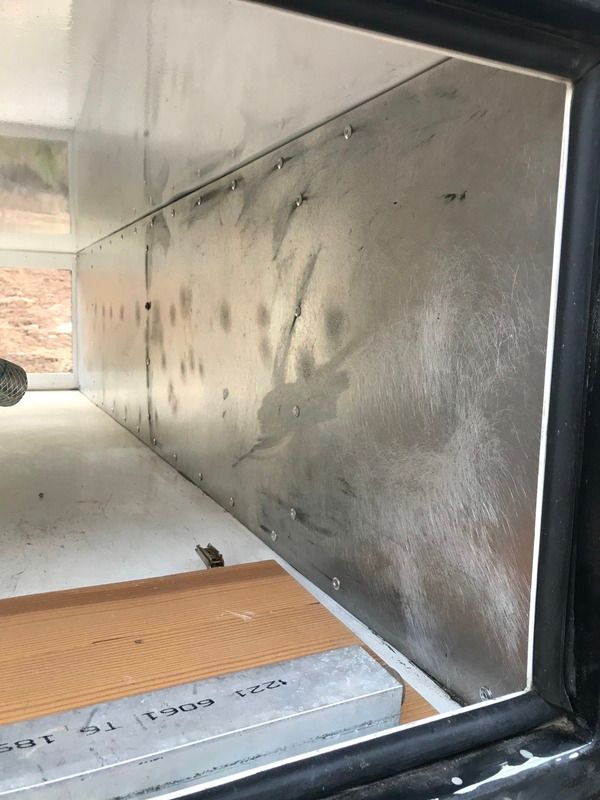
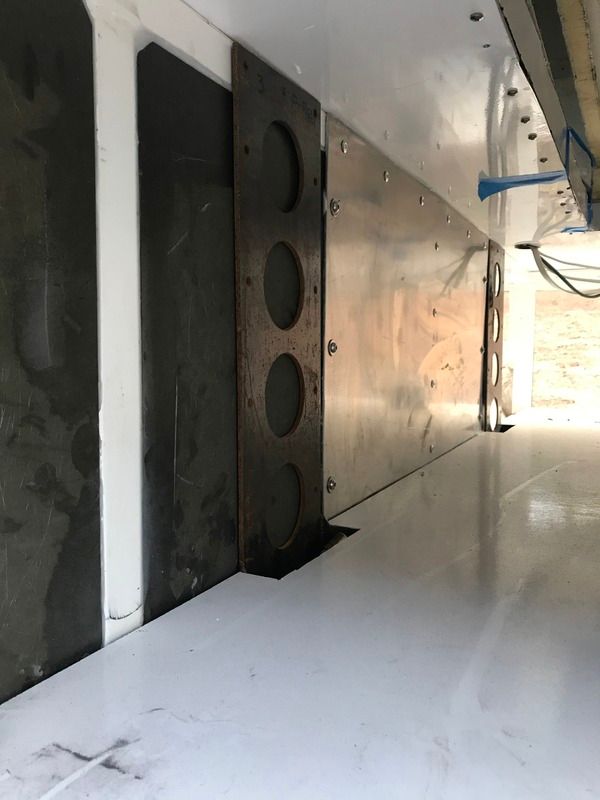
The mount points now bolt directly to the subframe, and then through bolt to both crossmember of the locker and through the coosa all the way up.



The mount points now bolt directly to the subframe, and then through bolt to both crossmember of the locker and through the coosa all the way up.

Last edited:
Heres a pic of the test fit on the new storage boxes
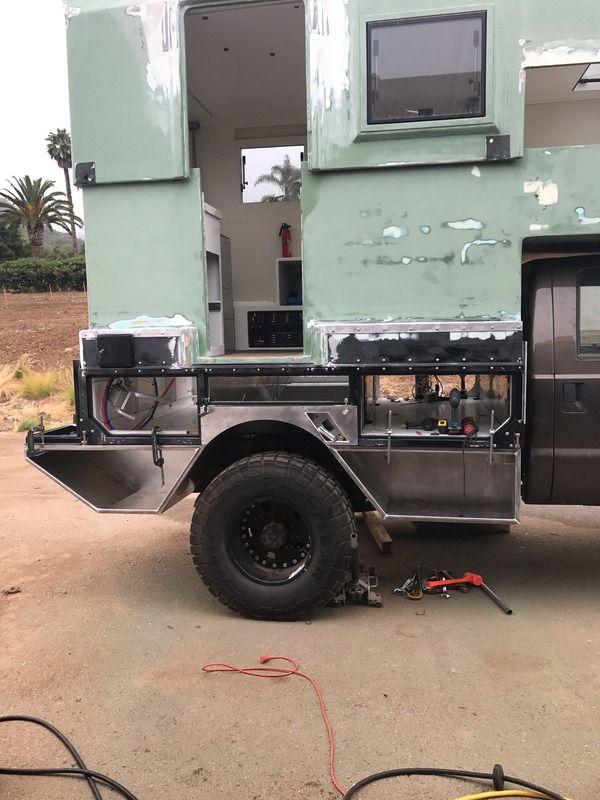
We were able to move the camper forward and down with the subframe redesign, but it moved the wheel back as a result. I designed these fascia plates to improve the aesthetics, but also to add an outdoor GFCI as well as 2 air quick connects. I'm building a new auto inflate and deflate pop off valve, so we'll hook all four wheels up, and then set to the desired pressure and let it go.
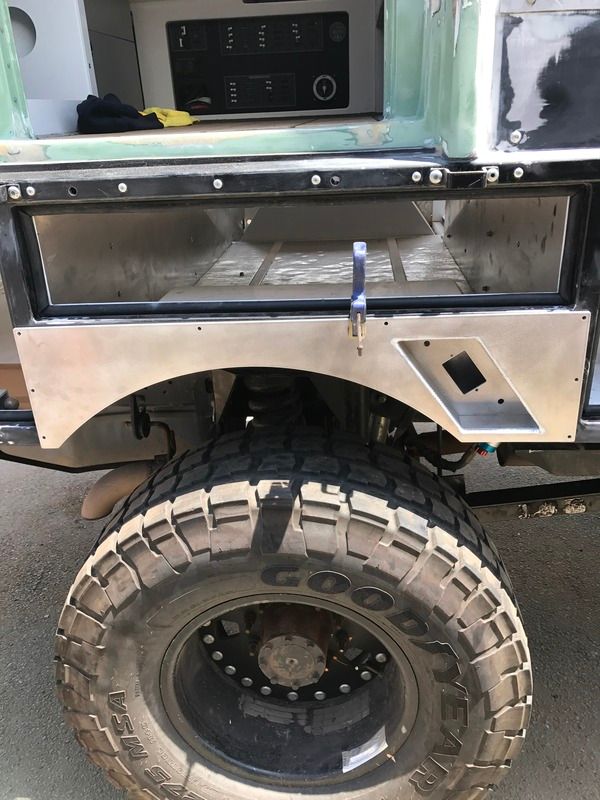
Here's the new AC unit cover with our logo on it. Sent this out to get water jetted locally.


We were able to move the camper forward and down with the subframe redesign, but it moved the wheel back as a result. I designed these fascia plates to improve the aesthetics, but also to add an outdoor GFCI as well as 2 air quick connects. I'm building a new auto inflate and deflate pop off valve, so we'll hook all four wheels up, and then set to the desired pressure and let it go.

Here's the new AC unit cover with our logo on it. Sent this out to get water jetted locally.

Last edited:
Wanted to put in a quick plug for Nate Jones Cowboy Tire in SoCal as well. I had so many balancing issues with this unit. The original beadlocks were too small for the tires. We had someone try to fix it with urethane to create a spacer and bond it in place, but it made a serious mess and the beads still moved a bit. I finally bought an oversized set for 11" rim and machined it myself to size after some careful measurements (Hutchinson was worse than useless when it came to trying to get info on expected beadlock compression amounts). After finally getting the beadlocks to work, we tried balancing beads with middling results. I took it down to Nate Jones who did a combo of tire shaving, old school traditional balancing, and then a final balance with the tire on the truck, which balanced the entire wheel and rotor assembly. Its now amazingly smooth. He's really a master.
pappawheely
Autonomous4X4
We also redesigned the captive spring mount up front and added a uhmw lined retaining plate. The spring bolt unit is also lined with an uhmw sleeve. Without the retaining plate and the bolt sleeve, the unit was able to move back and forth up front, which resulted in the bolts doing the shear retaining. It wasn't a great long term solution, but also resulted in a ton of squeeking.
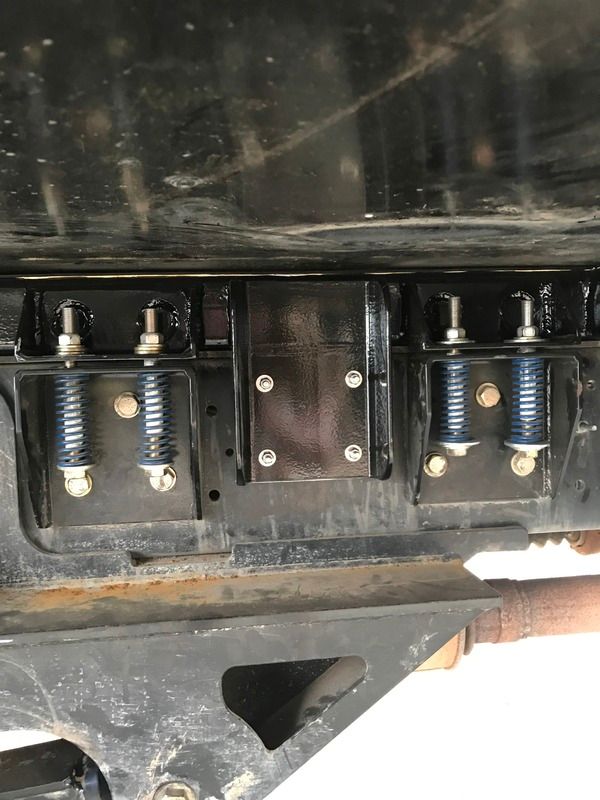
What is the rate on those springs?
An undamped spring is typically a mess. You would not run your car or motorcycle down the road without shocks, so why do people attempt to rely on basic coil springs or truck frames to be part of a suspension system?
IMO, a truck frame should not twist much and certainly should not be "noodly". That truck frame twisting back and forth is basically an undamped springs. You have no way to control where, when or to what degree it flexes. Making a rigid frame, whether frame rails, sub frame or carbon fiber monocoque on an F1 car, allows the other components of the system to do their job properly and effectively. Further, if you have the ability, a rigid frame allows adjustment and tuning of those systems.
Can you imagine your Baja 1000 buddy trying to tune his suspension for a race with a chassis that bent and flexed everywhere? How do you know what the coil-overs are doing? Is the suspension moving or is your chassis flexing? It would be a nightmare.
I realise that truck frames flex some and someone will chime in a with a picture of a Unimog all twisted up. I get it, Daimler designed the frame to flex and many builders insist on a three point mount, though that is slowly being replaced by something along the lines of what is pictured above. In the Unimog example, flex is designed into the system, but it is still not damped or controlled in any way. You have no way to adjust or minimise the movement of the camper box, as it flops back and forth from side to side.
Ideally, the F-550 frame should be reinforced, either with double C-channel or with inner wall plates, everywhere there is C-channel and not a fully boxed frame. The advantage of a fully boxed frame is that you can actually use a thinner gauge metal because you have the strength of a box section. This improves rigidity and actually decreases weight.
In mild steel, per foot of frame rail, you could easily see a savings of two pounds. Multiply that by 50-60 feet (both frame rails and all cross members, and you have a weight savings of over 100 pounds, plus you have a more rigid chassis or frame to boot. Unfortunately adding reinforcement to reduce "noodly" is going to add some weight, but I would be willing to take the hit to have a proper suspension, were I to be in your shoes.
The same goes for the RV box, consider some mountain bike shocks or something similar that can be adjusted to control the damping as the box moves around. (Notice Damping, not Dampening) Unless you are continually soaking your suspension with water, the latter simply does not apply)
Pick your Baja buddies brain, I bet he has some ideas or can get you to the right people.
Cheers
IMO, a truck frame should not twist much and certainly should not be "noodly". That truck frame twisting back and forth is basically an undamped springs. You have no way to control where, when or to what degree it flexes. Making a rigid frame, whether frame rails, sub frame or carbon fiber monocoque on an F1 car, allows the other components of the system to do their job properly and effectively. Further, if you have the ability, a rigid frame allows adjustment and tuning of those systems.
Can you imagine your Baja 1000 buddy trying to tune his suspension for a race with a chassis that bent and flexed everywhere? How do you know what the coil-overs are doing? Is the suspension moving or is your chassis flexing? It would be a nightmare.
I realise that truck frames flex some and someone will chime in a with a picture of a Unimog all twisted up. I get it, Daimler designed the frame to flex and many builders insist on a three point mount, though that is slowly being replaced by something along the lines of what is pictured above. In the Unimog example, flex is designed into the system, but it is still not damped or controlled in any way. You have no way to adjust or minimise the movement of the camper box, as it flops back and forth from side to side.
Ideally, the F-550 frame should be reinforced, either with double C-channel or with inner wall plates, everywhere there is C-channel and not a fully boxed frame. The advantage of a fully boxed frame is that you can actually use a thinner gauge metal because you have the strength of a box section. This improves rigidity and actually decreases weight.
In mild steel, per foot of frame rail, you could easily see a savings of two pounds. Multiply that by 50-60 feet (both frame rails and all cross members, and you have a weight savings of over 100 pounds, plus you have a more rigid chassis or frame to boot. Unfortunately adding reinforcement to reduce "noodly" is going to add some weight, but I would be willing to take the hit to have a proper suspension, were I to be in your shoes.
The same goes for the RV box, consider some mountain bike shocks or something similar that can be adjusted to control the damping as the box moves around. (Notice Damping, not Dampening) Unless you are continually soaking your suspension with water, the latter simply does not apply)
Pick your Baja buddies brain, I bet he has some ideas or can get you to the right people.
Cheers
pappawheely
Autonomous4X4
An undamped spring is typically a mess. You would not run your car or motorcycle down the road without shocks, so why do people attempt to rely on basic coil springs or truck frames to be part of a suspension system?
IMO, a truck frame should not twist much and certainly should not be "noodly". That truck frame twisting back and forth is basically an undamped springs. You have no way to control where, when or to what degree it flexes. Making a rigid frame, whether frame rails, sub frame or carbon fiber monocoque on an F1 car, allows the other components of the system to do their job properly and effectively. Further, if you have the ability, a rigid frame allows adjustment and tuning of those systems.
Can you imagine your Baja 1000 buddy trying to tune his suspension for a race with a chassis that bent and flexed everywhere? How do you know what the coil-overs are doing? Is the suspension moving or is your chassis flexing? It would be a nightmare.
I realise that truck frames flex some and someone will chime in a with a picture of a Unimog all twisted up. I get it, Daimler designed the frame to flex and many builders insist on a three point mount, though that is slowly being replaced by something along the lines of what is pictured above. In the Unimog example, flex is designed into the system, but it is still not damped or controlled in any way. You have no way to adjust or minimise the movement of the camper box, as it flops back and forth from side to side.
Ideally, the F-550 frame should be reinforced, either with double C-channel or with inner wall plates, everywhere there is C-channel and not a fully boxed frame. The advantage of a fully boxed frame is that you can actually use a thinner gauge metal because you have the strength of a box section. This improves rigidity and actually decreases weight.
In mild steel, per foot of frame rail, you could easily see a savings of two pounds. Multiply that by 50-60 feet (both frame rails and all cross members, and you have a weight savings of over 100 pounds, plus you have a more rigid chassis or frame to boot. Unfortunately adding reinforcement to reduce "noodly" is going to add some weight, but I would be willing to take the hit to have a proper suspension, were I to be in your shoes.
The same goes for the RV box, consider some mountain bike shocks or something similar that can be adjusted to control the damping as the box moves around. (Notice Damping, not Dampening) Unless you are continually soaking your suspension with water, the latter simply does not apply)
Pick your Baja buddies brain, I bet he has some ideas or can get you to the right people.
Cheers
Stock frames flex. Welding the entire length of the frame will add stiffness but requires complete disassembly. In the end, it will probably still flex. It's easy to build a rigid frame from scratch using a triangulated design. Truck frames don't have that.
There is a reason heavy trucks are meant to twist. The springs holding the camper box to the frame should only move when the truck is really twisting and you are only going a few mph and not much damping is needed,the friction of the shear plates is probably enough.Although it wouldn't hurt to have some heavy, low speed damping, it's probably not needed.An undamped spring is typically a mess. You would not run your car or motorcycle down the road without shocks, so why do people attempt to rely on basic coil springs or truck frames to be part of a suspension system?
IMO, a truck frame should not twist much and certainly should not be "noodly". That truck frame twisting back and forth is basically an undamped springs. You have no way to control where, when or to what degree it flexes. Making a rigid frame, whether frame rails, sub frame or carbon fiber monocoque on an F1 car, allows the other components of the system to do their job properly and effectively. Further, if you have the ability, a rigid frame allows adjustment and tuning of those systems.
Can you imagine your Baja 1000 buddy trying to tune his suspension for a race with a chassis that bent and flexed everywhere? How do you know what the coil-overs are doing? Is the suspension moving or is your chassis flexing? It would be a nightmare.
I realise that truck frames flex some and someone will chime in a with a picture of a Unimog all twisted up. I get it, Daimler designed the frame to flex and many builders insist on a three point mount, though that is slowly being replaced by something along the lines of what is pictured above. In the Unimog example, flex is designed into the system, but it is still not damped or controlled in any way. You have no way to adjust or minimise the movement of the camper box, as it flops back and forth from side to side.
Ideally, the F-550 frame should be reinforced, either with double C-channel or with inner wall plates, everywhere there is C-channel and not a fully boxed frame. The advantage of a fully boxed frame is that you can actually use a thinner gauge metal because you have the strength of a box section. This improves rigidity and actually decreases weight.
In mild steel, per foot of frame rail, you could easily see a savings of two pounds. Multiply that by 50-60 feet (both frame rails and all cross members, and you have a weight savings of over 100 pounds, plus you have a more rigid chassis or frame to boot. Unfortunately adding reinforcement to reduce "noodly" is going to add some weight, but I would be willing to take the hit to have a proper suspension, were I to be in your shoes.
The same goes for the RV box, consider some mountain bike shocks or something similar that can be adjusted to control the damping as the box moves around. (Notice Damping, not Dampening) Unless you are continually soaking your suspension with water, the latter simply does not apply)
Pick your Baja buddies brain, I bet he has some ideas or can get you to the right people.
Cheers
twisty frame
besides UHAULER and pappawheely coments, I'ld add: ya sure you want a stiff frame if you are building a racing buggy, but it isn't necessary good and increases the likelihood of frame breakage to be high risk - unless you have the stiffening extremely well engineered. Also spring mounted sub-frame is standard procedure on trucks and one of the recommendations of manufacturers. The other is that the weight should be spread out along the ENTIRE truck frame. I did something a little bit different but still follow Fords recommendations. For my 550 I have a 2 point hinge mount on the end of the frame. the entire load can 'lift' - really the twisty frame actually moves away from the load sub-frame, the sub-frame does not flex thus you do not put torsional forces on the camper. you can see the result: http://forum.expeditionportal.com/t...ehicle-Economical-build?p=1515395#post1515395
and scroll to the second photo: http://livingstonejournal.com/learning-curve/
and about half way down: http://www.truckcampermagazine.com/off-road/extreme-rigs/how-to-build-a-world-ready-rig-part-1/
besides UHAULER and pappawheely coments, I'ld add: ya sure you want a stiff frame if you are building a racing buggy, but it isn't necessary good and increases the likelihood of frame breakage to be high risk - unless you have the stiffening extremely well engineered. Also spring mounted sub-frame is standard procedure on trucks and one of the recommendations of manufacturers. The other is that the weight should be spread out along the ENTIRE truck frame. I did something a little bit different but still follow Fords recommendations. For my 550 I have a 2 point hinge mount on the end of the frame. the entire load can 'lift' - really the twisty frame actually moves away from the load sub-frame, the sub-frame does not flex thus you do not put torsional forces on the camper. you can see the result: http://forum.expeditionportal.com/t...ehicle-Economical-build?p=1515395#post1515395
and scroll to the second photo: http://livingstonejournal.com/learning-curve/
and about half way down: http://www.truckcampermagazine.com/off-road/extreme-rigs/how-to-build-a-world-ready-rig-part-1/
Ask Doug Hackney and Robinson Fuso how their flexible stock frames (both of them) worked out...
I realise that a completely rigid frame is not possible, but I also understand how torsional and axial forces impact a frame and further an RV box mounted to that frame.
Good luck with whatever decision you make.
I realise that a completely rigid frame is not possible, but I also understand how torsional and axial forces impact a frame and further an RV box mounted to that frame.
Good luck with whatever decision you make.
